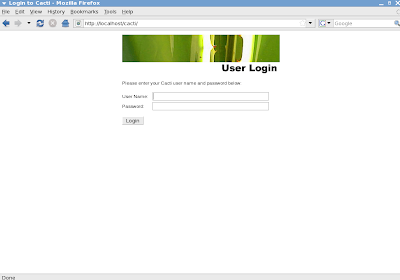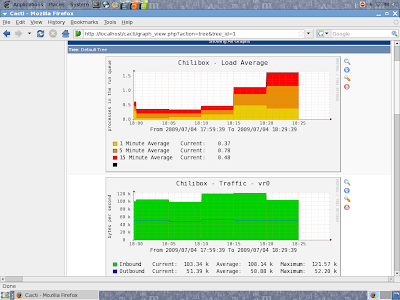
Cacti is a GPL-licensed, scalable, RRDtool-based monitoring program with flexible graphing options. This article describes the process of installing and configuring Cacti on CentOS 5.2.
Useful links to this installation were BXtra and TechDB.
Per the Cacti documentation, Cacti requires:
RRDTool 1.0.49 or 1.2.x or greaterI'd also recommend installing vim, net-snmp, net-snmp-utils, php-snmp, initscripts, perl-rrdtool, and any dependencies.
MySQL 4.1.x or 5.x or greater
PHP 4.3.6 or greater, 5.x greater highly recommended for advanced features
A Web Server e.g. Apache or IIS
To perform this install, I am logged into Gnome as a normal user, and opened a terminal that is switched to the root user using the su command. I had already installed apache, mysql, and PHP during the original install process of CentOS 5.2.
I added a new repository to facilitate this install. To do this, I created a file
(/etc/yum.repos.d/dag.repo) containing Dag Wiers repository, which contains rrdtool, among other things.
[dag] name=Dag RPM Repository for Red Hat Enterprise Linux baseurl=http://apt.sw.be/redhat/el5/en/i386/dag gpgcheck=1 gpgkey=http://dag.wieers.com/rpm/packages/RPM-GPG-KEY.dag.txt enabled=1
You can create this file by typing vim /etc/yum.repos.d/dag.repo and copying and pasting the above information into the file. Be warned that the above text containing the repository is version and architecture-specific.
I then typed yum update to update CentOS and the repository list before installing additional software.
I installed everything but cacti through yum. You can verify that you have the packages in question (or the version numbers of installed packages) by attempting to install them, as yum will remind you that you already have the latest version installed, as well as the version status of the packages, like shown here:
# yum install php httpd mysql mysql-server php-mysql vim-enhanced net-snmp net-snmp-utils php-snmp initscripts perl-rrdtool rrdtool initscripts
Loaded plugins: fastestmirror, priorities
Loading mirror speeds from cached hostfile
* base: pubmirrors.reflected.net
* updates: mirror.fdcservers.net
* addons: chi-10g-1-mirror.fastsoft.net
* extras: mirror.fdcservers.net
Setting up Install Process
Parsing package install arguments
Package php-5.1.6-23.2.el5_3.i386 already installed and latest version
Package httpd-2.2.3-22.el5.centos.1.i386 already installed and latest version
Package mysql-5.0.45-7.el5.i386 already installed and latest version
Package mysql-server-5.0.45-7.el5.i386 already installed and latest version
Package php-mysql-5.1.6-23.2.el5_3.i386 already installed and latest version
Package 2:vim-enhanced-7.0.109-4.el5_2.4z.i386 already installed and latest version
Package 1:net-snmp-5.3.2.2-5.el5_3.1.i386 already installed and latest version
Package 1:net-snmp-utils-5.3.2.2-5.el5_3.1.i386 already installed and latest version
Package php-snmp-5.1.6-23.2.el5_3.i386 already installed and latest version
Package initscripts-8.45.25-1.el5.centos.i386 already installed and latest version
Package perl-rrdtool-1.3.7-1.el5.rf.i386 already installed and latest version
Package rrdtool-1.3.7-1.el5.rf.i386 already installed and latest version
Package initscripts-8.45.25-1.el5.centos.i386 already installed and latest version
Nothing to do
Download the latest version of Cacti (0.8.7e, as of the writing of this article) from here. I downloaded it to my desktop and unzipped it by right clicking it and selecting "Extract here". I also renamed the cacti-0.8.7e directory by right clicking and selecting "Rename". You could do this in the command line, if you wanted to:
[your root shell] # tar xzvf cacti-0.8.7e.tar.gzMove the entire cacti directory to /var/www/html/ :
[your root shell] # mv cacti-0.8.7e cacti
[your root shell] # mv cacti /var/www/htmlI chose to create a 'cactiuser' user (and cacti group) to run cacti commands and to have ownership of the relavent cacti files. It was here that I noticed that my install did not have any of the /sbin directories in its $PATH , so I simply typed the absolute path:
[your root shell] # /usr/sbin/groupadd cactiChange the ownership of the /var/www/html/cacti/rra/ and /var/www/html/cacti/log/ directories to the cactiuser we just created:
[your root shell] # /usr/sbin/useradd -g cacti cactiuser [your root shell] # passwd cactiuser
[your root shell] # cd /var/www/html/cacti
[your root shell] # chown -R cactiuser rra/ log/
Create a mysql root password, if you haven't already (password in this example is samplepass:
[your root shell] # /usr/bin/mysqladmin -u root password samplepass
Create a MySQL database for cacti:
[your root shell] # mysqladmin --user=root --password=samplepass create cacti
Change directories to the cacti directory, and use the cacti.sql file to create tables for your database:
[your root shell] # cd /var/www/html/cacti
[your root shell- cacti] # mysql --user=root --password=samplepass cacti < cacti.sql
I also created a MySQL username and password for Cacti:
[your root shell] # mysql --user=root --password=samplepass
Welcome to the MySQL monitor. Commands end with ; or \g.
Your MySQL connection id is 28
Server version: 5.0.45 Source distribution
Type 'help;' or '\h' for help. Type '\c' to clear the buffer.
mysql> GRANT ALL ON cacti.* TO cactiuser@localhost IDENTIFIED BY 'samplepass';
Query OK, 0 rows affected (0.00 sec)
mysql> flush privileges;
Query OK, 0 rows affected (0.00 sec)
mysql> exit
Bye
Edit /var/www/html/cacti/include/config.php with your favorite editor, and update the information to reflect our cacti configuration (you can leave the other text in the file alone):
/* make sure these values refect your actual database/host/user/password */Create a cron job that polls for information for Cacti (I'm choosing to use /etc/crontab here):
$database_type = "mysql";
$database_default = "cacti";
$database_hostname = "localhost";
$database_username = "cactiuser";
$database_password = "samplepass";
$database_port = "3306";
[your root shell] # vim /etc/crontab
Add this line to your crontab:
*/5 * * * * cactiuser /usr/bin/php /var/www/html/cacti/poller.php > /dev/null 2>&1Edit your PHP config file at /etc/php.ini to allow more memory usage for Cacti. It is a relatively large text file- using vim, I search for "memory_limit" by typing /memory_limit in command mode.[your root shell] # vim /etc/php.iniBefore I check to see if Cacti works, I want to check and see if mysqld and httpd are running using the service command.
I changed memory_limit = 8M to memory_limit = 128M
[your root shell] # /sbin/service mysqld status
[your root shell] # /sbin/service httpd status
If mysqld and httpd are running, great. If not, type:
[your root shell] # /sbin/service mysqld startIf you're an "I need to see what the output looks like" type, here is an example of the previous command:
[your root shell] # /sbin/service httpd start
[your root shell] # /sbin/service mysqld statusYou should now be able to access cacti at http://localhost/cacti from the local computer or from any computer within your LAN network at http://your.internal.IP.address/cacti .
mysqld is stopped
[your root shell] # /sbin/service mysqld start
Initializing MySQL database: Installing MySQL system tables...
OK
Filling help tables...
OK
To start mysqld at boot time you have to copy
support-files/mysql.server to the right place for your system
PLEASE REMEMBER TO SET A PASSWORD FOR THE MySQL root USER !
To do so, start the server, then issue the following commands:
/usr/bin/mysqladmin -u root password 'new-password'
/usr/bin/mysqladmin -u root -h localhost.localdomain password 'new-password'
See the manual for more instructions.
You can start the MySQL daemon with:
cd /usr ; /usr/bin/mysqld_safe &
You can test the MySQL daemon with mysql-test-run.pl
cd mysql-test ; perl mysql-test-run.pl
Please report any problems with the /usr/bin/mysqlbug script!
The latest information about MySQL is available on the web at
http://www.mysql.com
Support MySQL by buying support/licenses at http://shop.mysql.com
[ OK ]
Starting MySQL: [ OK ]
There should be a Cacti Installation Guide window that shows up, giving licensing info and the like. Click "Next".
Select "New Installation", since this is a new installation.
The next window to pop up should tell you whether Cacti could find the paths to all of the elements that Cacti needs to run, such as RRDtool, PHP, snmp stuff, etc. If everything but Cacti was installed via yum, you should be good here. Click "Finish" to save the settings and bring up the login window.
Below is a screenshot of the login window. The default user name is admin. The default password is admin. It should prompt an automatic password change for the admin account when you log in the first time.

If you successfully log in, I'd recommend taking a break here. Depending on how fast you are, your cron job may not have had enough time to run the poller program and create data for your graphs. I'd suggest taking a deep breath, or brewing a cup of tea (or coffee) for yourself.
The localhost machine should have some graph templates that are already created, but you can click the "Create Additional Devices" link to add graphs for any other machines on your network. I added my FreeNAS box (tutorial for that to follow).
After having consumed your beverage of choice, press the "Graphs" button. Cacti should have a graph showing you a couple minutes of data for the machines you have added. The longer your machine is on, the more informational the graphs will be. Also, if you click on a particular graph, Cacti will Congratulations! You're now monitoring!
View the Cacti documentation page for more information on how to take advantages of Cacti.
Below are some graphs that were made using Cacti.


No comments:
Post a Comment